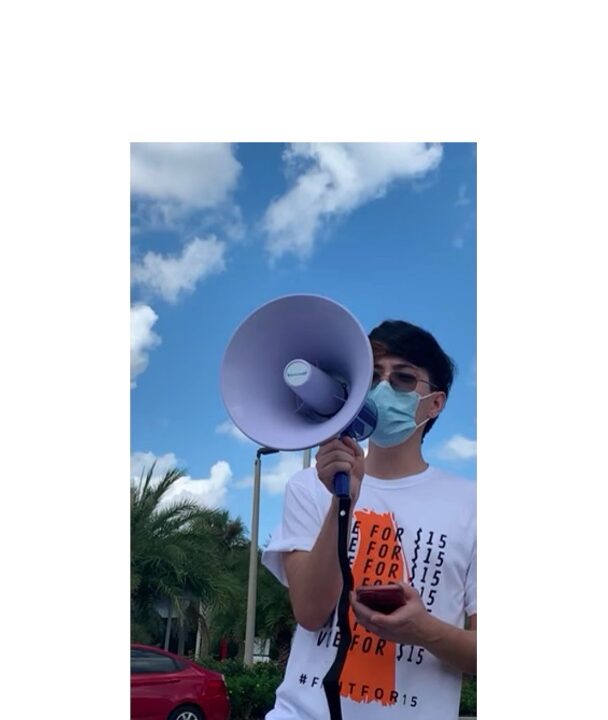Sammy Conde started working at a Starbucks in Orlando, Florida, after college, and struggled to make ends meet. They joined the Fight for $15 around the time the COVID-19 virus started to spread and became active in the campaign when Starbucks rolled back a small pay increase the company had begun offering workers at the beginning of the pandemic. Conde eventually became a member organizer with the Fight for $15 and the campaign to approve Amendment Two. They spoke with Mat Hanson of The Forge about digital organizing during COVID, how the campaign used direct actions, and why raising the minimum wage is a bipartisan issue.
Tell us about how you got involved in the campaign and what your experience on it was like.
I had a few different roles. I talked to my coworkers, but that effort has been kind of a slow burn. Part of my role was as a member organizer and speaking to the media because that helped get out the word to voters about what’s going on with fast food. Those of us who have been speaking to the media have made a difference, and that’s a huge part of why the Amendment Two ballot initiative passed. We also reached out to voters digitally, using media interviews and strikes.
We were calling, texting, recruiting volunteers and getting people involved so that we could get as many people out to vote for Amendment Two across a broad political spectrum, across many communities. We’re not talking just targeting Democrats but also people in all parties who are affected by poverty. I think digital organizing is the future of organizing. And we’ve really seen that come to light in 2020. Fight for $15 and Florida in particular gave some really strong examples of how to do that effectively.
How did you use digital organizing to bring people into the campaign?
I think the most effective way we got people involved was that we found people who we had personal connections with, who we knew cared about the Fight for $15, and we brought them into the campaign. And then we asked them to do the same thing.
When it comes to issues-based advocacy, storytelling is so important. With relational organizing, it’s easy because it’s someone who knows me and they already know my story. But for the new people getting involved, it’s key that you give on-message storytelling. There’s a lot of misinformation about [who a minimum wage worker is; a lot of people will say:] “Oh, only college kids work at McDonald’s and Starbucks.” [As part of our campaign,] a worker went out to do grocery shopping with a local politician to shop on a budget of $25 for a week. That’s the reality of living on the minimum wage of $8.56 in Florida. Those kinds of stories hook people in and get them to want to change that situation because they realize how wrong it is.
Amendment Two passed with overwhelming support and, even though raising the minimum wage is opposed by almost every elected Republican, it is incredibly popular with all voters, regardless of their party affiliation. Tell us about how you broke through to voters.
First, we have to realize that Republicans work at the minimum wage. So when we share the stories of people who work minimum wage jobs, it strikes a chord because people understand that we’re not making enough; people know people who live these realities. And once they connect to that story, it’s hard to argue otherwise. You just can’t live on less than $15 an hour.
Republicans in Florida have also been pushing back on socialism or what they might deem to be socialism, but socialism isn’t just for poor people. The reality is that these companies are not paying their workers. So we have to subsidize that. The fact that I’m on food stamps because I only make $11 an hour is so that the people who are in charge of Starbucks can make more money and the state of Florida can pay for me to eat. And because of that, a lot of Floridians who are Republicans will say, this is not fiscally conservative. This is not a functioning economy. This is allowing companies to take advantage of Floridians and use our resources and not adequately pay their workers. If we adequately paid our workers, then not as many people would be on food stamps. Those messages really resonate with people who like small government and who do not want to see their neighbors suffer. And I think that’s a universal message, right? We want effective government. We want people to make a living. We want people to be able to have upward momentum if they put the work into it — and the way the system is set up right now, that’s not possible.
How did you get out the vote for Amendment Two?
There were multiple levels. There’s the media level where they have workers speaking in the media about their story. And that in part is to combat misinformation because we want to make sure that everyone who’s going out to vote hears our story, and not just the story of people who want to profit from the wages.
[We also organized] strikes so that we were visible and people heard our stories directly from us with no filters. Sometimes, we would bring in popular local political figures. And some people would ask to be involved, like small business owners who supported the Fight for $15. And that was really powerful messaging because there are a lot of employers who want their workers to have a decent life and want them to be able to afford to live in the communities that they work in.
We also reached out to voters directly. We hit hard on social media. We have a social media team that would relay messages and share the stories of the workers. And then the member paid organizers really focused on sharing those messages with people who they could share those messages with, through relational organizing and sharing on their own social media. We also really worked hard on direct voter outreach through phone banking, text banking, email. And that was very targeted.
What role did strike actions play in the campaign?
Strikes are really important because you need to see that the workers are upset to understand why this needs to change. It shows the local population, hey, all these McDonald’s workers just went on strike and they’re trying to form a union, what’s going on there? And then they do the research and they see our stories in the media and all this stuff that we’ve been doing starts to circle back around. And so having a strike makes people ask questions and makes people listen to us.
What’s next for the campaign?
We are putting pressure on Marco Rubio and Rick Scott to support the $15 minimum wage nationally, because 61 percent of Floridians support the minimum wage. And we’re speaking out against the Florida legislature, which is trying to take away the $15 minimum wage for certain groups of people, like returning citizens, anyone who’s under 21, and “anyone who is hard to hire.” Our opponents are very invested in trying to keep that $15 out of as many hands as possible. That’s why we’re continuing to go on strike, continuing to share our stories, continuing to organize.


